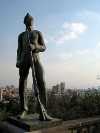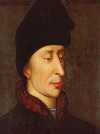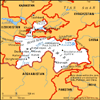 In 1830, festivities were held to mark the opening of the Liverpool and Manchester Railway, the world’s first inter-city passenger railway. Unfortunately, the celebration turned tragic when William Huskisson, the Member of Parliament for Liverpool, got off the train to speak with the Duke of Wellington during a temporary stop and was fatally injured by an oncoming train. He thus became the world’s first railway passenger to be killed by a train. How fast did these trains initially travel? Discuss
In 1830, festivities were held to mark the opening of the Liverpool and Manchester Railway, the world’s first inter-city passenger railway. Unfortunately, the celebration turned tragic when William Huskisson, the Member of Parliament for Liverpool, got off the train to speak with the Duke of Wellington during a temporary stop and was fatally injured by an oncoming train. He thus became the world’s first railway passenger to be killed by a train. How fast did these trains initially travel? Discuss
Source: The Free Dictionary
 Described in Leo Tolstoy’s War and Peace, the Battle of Borodino was the largest and bloodiest single-day action of the Napoleonic Wars. An estimated 100,000 people died in the battle between the Russian forces of General Mikhail Kutuzov and Napoleon’s Grande Armée. After severely battering but not totally defeating the Russians, Napoleon’s forces marched the 70 miles (110 km) to Moscow and entered the city. As the population evacuated, fires engulfed much of the city. Who caused them?
Described in Leo Tolstoy’s War and Peace, the Battle of Borodino was the largest and bloodiest single-day action of the Napoleonic Wars. An estimated 100,000 people died in the battle between the Russian forces of General Mikhail Kutuzov and Napoleon’s Grande Armée. After severely battering but not totally defeating the Russians, Napoleon’s forces marched the 70 miles (110 km) to Moscow and entered the city. As the population evacuated, fires engulfed much of the city. Who caused them?  Los Niños Héroes—the “Boy Heroes”—were six teenage Mexican army cadets who died defending Mexico City’s Chapultepec Castle from invading US forces during the Mexican-American War. Ignoring orders to fall back, the young cadets fought until the end. According to many accounts, the last survivor leapt from the castle roof wrapped in the Mexican flag to prevent it from being taken. What US President visited the monument honoring the cadets a few months before the battle’s 100th anniversary?
Los Niños Héroes—the “Boy Heroes”—were six teenage Mexican army cadets who died defending Mexico City’s Chapultepec Castle from invading US forces during the Mexican-American War. Ignoring orders to fall back, the young cadets fought until the end. According to many accounts, the last survivor leapt from the castle roof wrapped in the Mexican flag to prevent it from being taken. What US President visited the monument honoring the cadets a few months before the battle’s 100th anniversary?  In 1940, four teens uncovered a fantastic archeological site, a cave system decorated with prehistoric paintings, drawings, and engravings that have been dated to about 15,000–13,000 BCE. Many of the paintings are drawn over former works, enabling experts to trace stylistic developments over more than 1,000 years. The later paintings, featuring animals along with signs and symbols, exhibit an advanced artistic quality and technical skill. Why was the cave closed to the public in 1963?
In 1940, four teens uncovered a fantastic archeological site, a cave system decorated with prehistoric paintings, drawings, and engravings that have been dated to about 15,000–13,000 BCE. Many of the paintings are drawn over former works, enabling experts to trace stylistic developments over more than 1,000 years. The later paintings, featuring animals along with signs and symbols, exhibit an advanced artistic quality and technical skill. Why was the cave closed to the public in 1963?  On September 11, 2001, 19 Al-Qaeda terrorists hijacked four commercial airplanes. They crashed two planes into the World Trade Center’s Twin Towers in New York City and flew a third into the Pentagon building in Virginia. Passengers on the fourth flight attempted to retake control of the aircraft, but it crashed in a Pennsylvania field. The devastating terrorist attacks of 9/11 were responsible for 2,996 deaths and countless more injuries. What were the environmental consequences of 9/11?
On September 11, 2001, 19 Al-Qaeda terrorists hijacked four commercial airplanes. They crashed two planes into the World Trade Center’s Twin Towers in New York City and flew a third into the Pentagon building in Virginia. Passengers on the fourth flight attempted to retake control of the aircraft, but it crashed in a Pennsylvania field. The devastating terrorist attacks of 9/11 were responsible for 2,996 deaths and countless more injuries. What were the environmental consequences of 9/11?  Son of Philip the Bold, John the Fearless was duke of Burgundy from 1404–1419. He continued his father’s feud with Louis, Duke of Orléans, brother of King Charles VI, and became popular by advocating reforms. In 1407, he had Louis assassinated and later obtained control of the French government. Rivalry with the supporters of Orléans led to civil war in 1411, and he seized Paris in 1418. At a negotiation meeting with the dauphin—the future King Charles VII—John was assassinated. Who killed him?
Son of Philip the Bold, John the Fearless was duke of Burgundy from 1404–1419. He continued his father’s feud with Louis, Duke of Orléans, brother of King Charles VI, and became popular by advocating reforms. In 1407, he had Louis assassinated and later obtained control of the French government. Rivalry with the supporters of Orléans led to civil war in 1411, and he seized Paris in 1418. At a negotiation meeting with the dauphin—the future King Charles VII—John was assassinated. Who killed him?  Russia first took control of Tajik lands in the 1880s. In the aftermath of the 1917 Russian Revolution, the Tajiks rebelled against Russian rule, and the Red Army did not retake control until 1921. Tajikistan was made an autonomous republic within Uzbekistan in 1924 and joined the USSR in 1929. In 1991, at around the time the USSR was being dissolved, the Republic of Tajikistan declared its independence. Civil war broke out a year later. When was a peace agreement reached?
Russia first took control of Tajik lands in the 1880s. In the aftermath of the 1917 Russian Revolution, the Tajiks rebelled against Russian rule, and the Red Army did not retake control until 1921. Tajikistan was made an autonomous republic within Uzbekistan in 1924 and joined the USSR in 1929. In 1991, at around the time the USSR was being dissolved, the Republic of Tajikistan declared its independence. Civil war broke out a year later. When was a peace agreement reached?  The Honda Point Disaster was the largest peacetime loss of US Navy ships. On the evening of September 8, 1923, 14 destroyers were engaging in simulated combat maneuvers a few miles from the northern side of the Santa Barbara Channel off the California coast. Upon reaching Honda Point, seven destroyers ran aground and were wrecked; two others suffered minor damage. In all, twenty-three sailors lost their lives. What is the “Devil’s Jaw,” and how did it factor into the incident?
The Honda Point Disaster was the largest peacetime loss of US Navy ships. On the evening of September 8, 1923, 14 destroyers were engaging in simulated combat maneuvers a few miles from the northern side of the Santa Barbara Channel off the California coast. Upon reaching Honda Point, seven destroyers ran aground and were wrecked; two others suffered minor damage. In all, twenty-three sailors lost their lives. What is the “Devil’s Jaw,” and how did it factor into the incident?  The thylacine, known also as the Tasmanian wolf and Tasmanian tiger, was a carnivorous marsupial once found on the Australian mainland, New Guinea, and Tasmania. Often cited as an example of convergent evolution, it was superficially similar to a wolf or dog, though it evolved entirely independently of these animals. It was hunted to probable extinction in the 1930s, and the last captive thylacine died in the Hobart Zoo in 1936. How many thylacine sightings have been reported since then?
The thylacine, known also as the Tasmanian wolf and Tasmanian tiger, was a carnivorous marsupial once found on the Australian mainland, New Guinea, and Tasmania. Often cited as an example of convergent evolution, it was superficially similar to a wolf or dog, though it evolved entirely independently of these animals. It was hunted to probable extinction in the 1930s, and the last captive thylacine died in the Hobart Zoo in 1936. How many thylacine sightings have been reported since then?  In 1901, anarchist Leon Czolgosz shot US President William McKinley at the Pan-American Exposition, a World’s Fair in Buffalo, New York. McKinley died a week later, and Czolgosz was convicted of his murder and executed that same year. Though judged sane during the trial, Czolgosz is believed by some to have been mentally unstable after suffering a breakdown years earlier. What Broadway musical incorporates the story of Czolgosz with those of eight other presidential assassins?
In 1901, anarchist Leon Czolgosz shot US President William McKinley at the Pan-American Exposition, a World’s Fair in Buffalo, New York. McKinley died a week later, and Czolgosz was convicted of his murder and executed that same year. Though judged sane during the trial, Czolgosz is believed by some to have been mentally unstable after suffering a breakdown years earlier. What Broadway musical incorporates the story of Czolgosz with those of eight other presidential assassins?